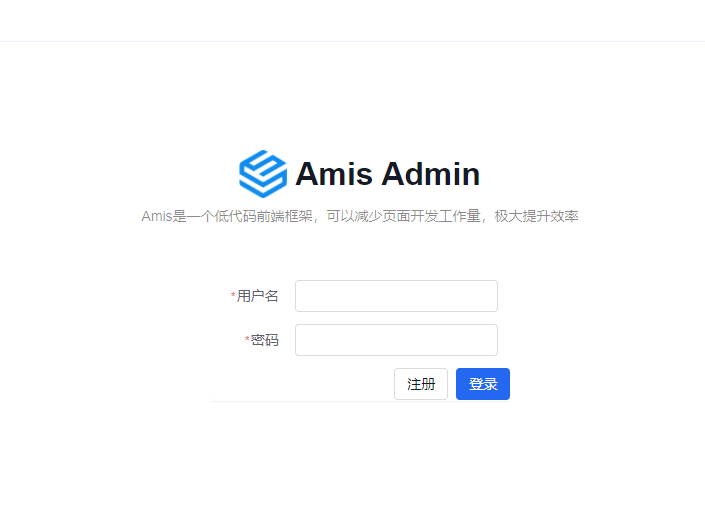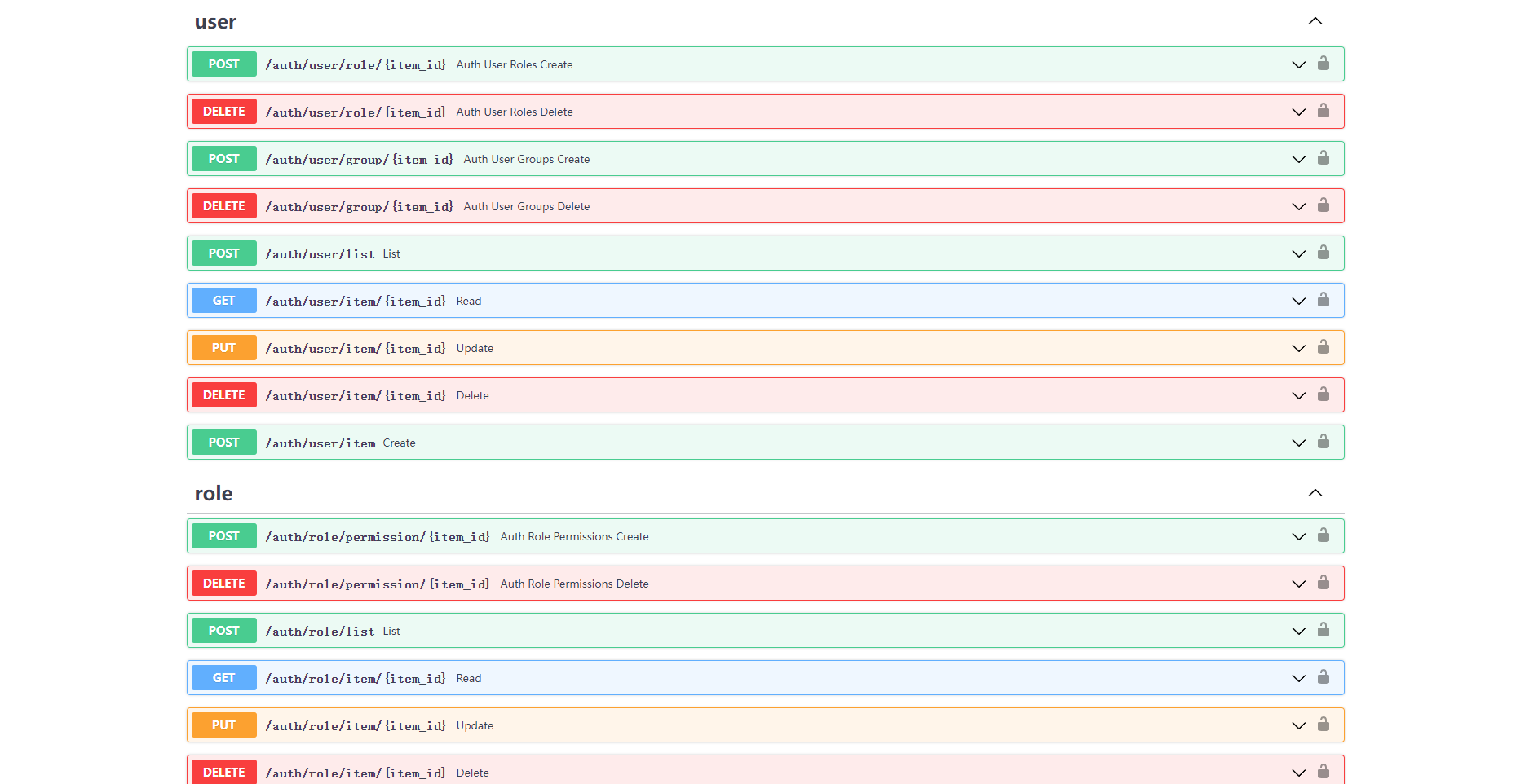FastAPI-User-Auth is a simple and powerful FastAPI user RBAC authentication and authorization library. Based on FastAPI-Amis-Admin and provides a freely extensible visual management interface.
Project description
Project Introduction
FastAPI-User-Auth
FastAPI-User-Auth is a simple and powerful FastAPI user RBAC authentication and authorization library.
It is based on FastAPI-Amis-Admin and provides a freely extensible visual management interface.
SourceCode · OnlineDemo · Documentation · Can't open the document?
FastAPI-User-Auth It is an application plug -in based on FastAPI-Amis-Admin
, which is deeply integrated to provide user authentication and authorization..
Install
pip install fastapi-user-auth
Simple example
from fastapi import FastAPI
from fastapi_amis_admin.admin.settings import Settings
from fastapi_user_auth.site import AuthAdminSite
from starlette.requests import Request
from sqlmodel import SQLModel
# Create Fast API application
app = FastAPI()
# Create an Admin Site instance
site = AuthAdminSite(settings=Settings(database_url_async='sqlite+aiosqlite:///amisadmin.db'))
auth = site.auth
# Mount the Site management system to the FastAPI instance
site.mount_app(app)
# Create initialization database table
@app.on_event("startup")
async def startup():
await site.db.async_run_sync(SQLModel.metadata.create_all, is_session=False)
# Create default test user, Please change your password in time!!!
await auth.create_role_user('admin')
await auth.create_role_user('vip')
# Requirements: User must be logged in
@app.get("/auth/get_user")
@auth.requires()
def get_user(request: Request):
return request.user
if __name__ == '__main__':
import uvicorn
uvicorn.run(app, debug=True)
Ways of identifying
Decorator
- Recommended scenario: Single route. Supports synchronous and asynchronous routing.
# Requirements: User must be logged in
@app.get("/auth/user")
@auth.requires()
def user(request: Request):
return request.user # current request user object.
# Authentication route: user has admin role
@app.get("/auth/admin_roles")
@auth.requires('admin')
def admin_roles(request: Request):
return request.user
# Requirement: User has vip role
# Support synchronous and asynchronous routing
@app.get("/auth/vip_roles")
@auth.requires(['vip'])
async def vip_roles(request: Request):
return request.user
# Requirements: User has admin role or vip role
@app.get("/auth/admin_or_vip_roles")
@auth.requires(roles=['admin', 'vip'])
def admin_or_vip_roles(request: Request):
return request.user
# Requirement: The user belongs to the admin user group
@app.get("/auth/admin_groups")
@auth.requires(groups=['admin'])
def admin_groups(request: Request):
return request.user
# Requirements: The user has the admin role and belongs to the admin user group
@app.get("/auth/admin_roles_and_admin_groups")
@auth.requires(roles=['admin'], groups=['admin'])
def admin_roles_and_admin_groups(request: Request):
return request.user
# Requirements: The user has the vip role and has the `article:update` permission
@app.get("/auth/vip_roles_and_article_update")
@auth.requires(roles=['vip'], permissions=['article:update'])
def vip_roles_and_article_update(request: Request):
return request.user
Dependencies (recommended)
- Recommended scenarios: single route, route collection, FastAPI application.
from fastapi import Depends
from typing import Tuple
from fastapi_user_auth.auth import Auth
from fastapi_user_auth.auth.models import User
# Route parameter dependencies, this method is recommended
@app.get("/auth/admin_roles_depend_1")
def admin_roles(user: User = Depends(auth.get_current_user)):
return user # or request.user
# Path manipulation decorator dependencies
@app.get("/auth/admin_roles_depend_2", dependencies=[Depends(auth.requires('admin')())])
def admin_roles(request: Request):
return request.user
# Global dependencies
# All requests under the app application require the admin role
app = FastAPI(dependencies=[Depends(auth.requires('admin')())])
@app.get("/auth/admin_roles_depend_3")
def admin_roles(request: Request):
return request.user
Middleware
- Recommended Scenario: FastAPI Application
app = FastAPI()
# Append `request.auth` and `request.user` objects before each request processing under the app
auth.backend.attach_middleware(app)
Call directly
- Recommended scenarios: non-routing methods
from fastapi_user_auth.auth.models import User
async def get_request_user(request: Request) -> Optional[User]:
# user= await auth.get_current_user(request)
if await auth.requires('admin', response=False)(request):
return request.user
else:
return None
Token storage backend
fastapi-user-auth Supports multiple token storage methods. The default is: DbTokenStore, It is recommended to customize the modification to: JwtTokenStore
JwtTokenStore
from fastapi_user_auth.auth.backends.jwt import JwtTokenStore
from sqlalchemy.ext.asyncio import create_async_engine
from sqlalchemy_database import AsyncDatabase
# Create an asynchronous database engine
engine = create_async_engine(url='sqlite+aiosqlite:///amisadmin.db', future=True)
# Create auth object using `Jwt Token Store`
auth = Auth(
db=AsyncDatabase(engine),
token_store=JwtTokenStore(secret_key='09d25e094faa6ca2556c818166b7a9563b93f7099f6f0f4caa6cf63b88e8d3e7')
)
# Pass the auth object into the Admin Site
site = AuthAdminSite(
settings=Settings(database_url_async='sqlite+aiosqlite:///amisadmin.db'),
auth=auth
)
DbTokenStore
# Create auth object using `Db Token Store`
from fastapi_user_auth.auth.backends.db import DbTokenStore
auth = Auth(
db=AsyncDatabase(engine),
token_store=DbTokenStore(db=AsyncDatabase(engine))
)
RedisTokenStore
# Create auth object using `Redis Token Store`
from fastapi_user_auth.auth.backends.redis import RedisTokenStore
from aioredis import Redis
auth = Auth(
db=AsyncDatabase(engine),
token_store=RedisTokenStore(redis=Redis.from_url('redis://localhost?db=0'))
)
RBAC model
The RBAC model adopted by this system is as follows, you can also expand it according to your own needs.
- Reference: Design of Permission System
flowchart LR
User -. m:n .-> Group
User -. m:n .-> Role
Group -. m:n .-> Role
Role -. m:n .-> Perimission
Advanced Extension
### Extending the `User` model
```python
from datetime import date
from fastapi_amis_admin.models.fields import Field
from fastapi_user_auth.auth.models import User
# Customize `User` model, inherit `User`
class MyUser(User, table = True):
point: float = Field(default = 0, title = 'Source', description = 'User source')
phone: str = Field(None, title = 'Phone number', max_length = 15)
parent_id: int = Field(None, title = "Superior", foreign_key = "auth_user.id")
birthday: date = Field(None, title = "Date of birth")
location: str = Field(None, title = "Location")
# Create an auth object using a custom `User` model
auth = Auth(db = AsyncDatabase(engine), user_model = MyUser)
Extend the Role, Group, Permission models
from fastapi_amis_admin.models.fields import Field
from fastapi_user_auth.auth.models import Group
# Customize the `Group` model, inherit `Base RBAC`; override the `Role`, the `Permission` model is similar,
# the difference is the table name.
class MyGroup(Group, table=True):
__tablename__ = 'auth_group' # Database table name, must be this to override the default model
icon: str = Field(None, title='Icon')
is_active: bool = Field(default=True, title="Activate now")
Custom User Auth App default management class
Default management classes can be overridden and replaced by inheritance.
For Example: UserLoginFormAdmin,UserRegFormAdmin,UserInfoFormAdmin,
UserAdmin,GroupAdmin,RoleAdmin,PermissionAdmin
# Customize the model management class, inherit and override the corresponding default management class
class MyGroupAdmin(admin.ModelAdmin):
group_schema = None
page_schema = PageSchema(label='用户组管理', icon='fa fa-group')
model = MyGroup
link_model_fields = [Group.roles]
readonly_fields = ['key']
# Customize the user authentication application, inherit and override the default user authentication application
class MyUserAuthApp(UserAuthApp):
GroupAdmin = MyGroupAdmin
# Customize the user management site, inherit and override the default user management site
class MyAuthAdminSite(AuthAdminSite):
UserAuthApp = MyUserAuthApp
# Create a site object using a custom `Auth Admin Site` class
site = MyAuthAdminSite(settings, auth=auth)
Interface/UI preview
- Open
http://127.0.0.1:8000/admin/auth/form/loginin your browser:
- Open
http://127.0.0.1:8000/admin/in your browser:
- Open
http://127.0.0.1:8000/admin/docsin your browser:
License
fastapi-amis-adminis based onApache2.0Open source is free to use and can be freely used for commercial purposes, but please clearly display the copyright information about Fast API-Amis-Admin in the display interface.
Thanks
Thanks to the following developers for their contributions to FastAPI-User-Auth:

Project details
Release history Release notifications | RSS feed
Download files
Download the file for your platform. If you're not sure which to choose, learn more about installing packages.
Source Distribution
Built Distribution
File details
Details for the file fastapi_user_auth-0.4.1.tar.gz.
File metadata
- Download URL: fastapi_user_auth-0.4.1.tar.gz
- Upload date:
- Size: 76.8 kB
- Tags: Source
- Uploaded using Trusted Publishing? No
- Uploaded via: python-requests/2.28.1
File hashes
| Algorithm | Hash digest | |
|---|---|---|
| SHA256 | f41b5b35f9d7232266eb249d51347aba733fd958b9909223dcc20ae4cba41a15 |
|
| MD5 | 4af74f273339e4e00182023ebdc59fd0 |
|
| BLAKE2b-256 | c2e177011b19ee26f7d2322eaf9c63f8b264de5224013362760bcea987b671cd |
File details
Details for the file fastapi_user_auth-0.4.1-py3-none-any.whl.
File metadata
- Download URL: fastapi_user_auth-0.4.1-py3-none-any.whl
- Upload date:
- Size: 23.5 kB
- Tags: Python 3
- Uploaded using Trusted Publishing? No
- Uploaded via: python-requests/2.28.1
File hashes
| Algorithm | Hash digest | |
|---|---|---|
| SHA256 | 536baf67f03a504f6715ff9b4a7834192a45e60a6e9918a288a53e90db164868 |
|
| MD5 | 00b211392141fb636c2558e302330cad |
|
| BLAKE2b-256 | 6bc8ccc4cab658f34528516a68d85b3d6011739ca349f842216b4ca22f177eea |



















